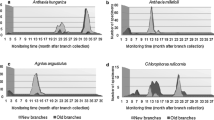Abstract
Endemic forests with Juniperus spp. in the Mediterranean are listed as a priority habitat in the EU Habitats Directive, with the stinking juniper tree (Juniperus foetidissima Willd.) a key constituent. Within the EU, the island of Cyprus represents the southernmost range of distribution of J. foetidissima with clumps of the tree located mostly on the rocky and steep slopes of the Troodos National Forest Park (NFP) between 1.500–1.950 m above sea level. The reproductive potential of J. foetidissima may be at risk, partly because of berry attacks by arthropods. To identify the arthropod species that infest J. foetidissima berries we sampled trees biweekly for one year at three elevations (1.950 m, 1.800 m, and 1.650 m). We identified four microlepidoptera species attacking berries: Pammene mariana (Zerny), P. juniperana (Millière), P. blockiana (Herrich-Schäffer) (Lepidoptera: Torticidae) and Argyresthia aurulentella Stainton (Lepidoptera: Yponomeutidae). Eriophyid mites were also recorded to feed on berries. All insect species are recorded for the first time in Cyprus. Infestation during the maturation period of berries collected by cutting varied from an average of 16% at the medium elevation (1.800 m) to 11% at the low elevation (1.650 m). Infestation of berries collected by beating remained above 30% during the berry maturation period.

Similar content being viewed by others
References
Anonymous. (2015). JUNIPERCY: Improving the conservation status of the priority habitat type 9560*. Final report for project LIFE10 NAT/CY/000717. www.junipercy.org.eu
Bates, D., Maechler, M., Boker, B., & Walker, S. (2015). Fitting linear mixed-effects models using lme4. Journal of Statistical Software, 67(1), 1–48.
Bolker, B. M., Brooks, M. E., Clark, C. J., Geange, S. W., Poulsen, J. R., Stevens, M. H. H., & White, J.-S. S. (2009). Generalized linear mixed models: A practical guide for ecology and evolution. Trends in Ecology and Evolution, 24(3), 127–135.
Castagnoli, M., Lewandowski, M., Łabanowski, G. S., Simoni, S., & Soika, G. M. (2010). An insight into some relevant aspects concerning eriophyoid mites inhabiting forests, ornamental trees and shrubs. Experimental and Appled Acarology, 51, 169–189.
Cyprus Meteorological Service. (2013). Temperature and precipitation data from Troodos station. Nicosia: Cyprus Meteorological Service.
DeSoto, L., Tutor, D., Torices, R., Rodríguez-Echeverría, S., & Nabais, C. (2016). Pre-dispersal predation effect on seed packaging strategies and seed viability. Oecologia, 180(1), 91–102.
Dimitri, L. A., Longland, W. S., Tonkel, K. C., Rector, B. G., & Kirchoff, V. S. (2018). Impacts of granivorous and frugivorous arthropods on pre-dispersal seed production of western juniper (Juniperus occidentalis). Arthropod-Plant Interactions, 12(3), 465–476.
Farjon, A. (2013). Juniperus foetidissima. The IUCN red list of threatened species 2013: e.T42234A2965043. https://doi.org/10.2305/IUCN.UK.2013-1.RLTS.T42234A2965043.en. Accessed 23 September 2016.
Folmer, O., Black, M., Hoeh, W., Lutz, R., & Vrijenhoek, R. (1994). DNA primers for amplification of mitochondrial cytochrome c oxidase subunit I from diverse metazoan invertebrates. Molecular Marine Biology Biotechnology, 3(5), 294–299.
Kolb, A., Ehrlén, J., & Eriksson, O. (2007). Ecological and evolutionary consequences of spatial and temporal variation in pre-dispersal seed predation. Perspectives in Plant Ecology, Evolution and Systematics, 9(2), 79–100.
Lodos, N., & Önder, F. (1979). Contribution to the study on the Turkish Pentatomidae (Heteroptera). IV. Family: Acanthosomatidae Stal 1864. Türkiye Bitki Koruma Dergisi, 3(3), 139–160.
Meikle, R. D. (1977). Flora of Cyprus (Vol. I, pp. 27–32). London: Royal Botanic Gardens, Kew.
R Core Team. (2017). R: A language and environment for statistical computing. In R Foundation for statistical computing. Vienna: Austria. URL https://www.R-project.org/.
Roques, A. (1983). Pests of conifer cones and seeds in France. French National Institute for Agricultural Research, Paris.
Roques, A., Copeland, R. S., Soldati, L., Denux, O., & Auger-Rozenberg, M.-A. (2016). Megastigmus seed chalcids (Hymenoptera, Torymidae) radiated much more on angiosperms than previously considered. I- description of 8 new species from Kenya, with a key to the females of eastern and southern Africa. ZooKeys, 585, 51–124.
Sanger, F., Nicklen, S., & Coulson, A. R. (1977). DNA sequencing with chain-terminating inhibitors. Proceedings of the National Academy of Sciences of the USA, 74(12), 5463–5467.
Shevchenko, V. G. (1962). New four legged mite—Trisetacus kirghisorum sp. n. (Acarina: Eriophyidae)—The pest of seeds of Asian mountain juniper. Proceeedings of Kirghyz Forest Experiment Station, 3, 299–305.
Silvertown, J., Franco, M., Pisantyt, I., & Mendoza, A. N. A. (1993). Comparative plant demography- relative importance of life-cycle components to the finite rate of increase in woody and herbaceous perennials. Journal of Ecology, 81(3), 465–476.
Strutzenberger, P., Brehm, G., & Fiedler, K. (2012). DNA barcode sequencing from old type specimens as a tool in taxonomy: A case study in the diverse genus Eois (Lepidoptera: Geometridae). PLoS One, 7(11), e49710.
Tamura, K., Peterson, D., Peterson, N., Stecher, G., Nei, M., & Kumar, S. (2011). MEGA5: Molecular evolutionary genetics analysis using maximum likelihood. Evolutionary distance and maximum parsimony methods. Molecular Biology and Evolution, 28(10), 2731–2739.
Ward, L. K. (1982). The conservation of Juniper: Longevity and old age. Journal of Applied Ecology, 19, 917–928.
Acknowledgements
We are grateful to Dr. Ole Karsholt (Natural History Museum of Denmark) and Dr. Berend Aukema (Naturalis Biodiversity Center, Netherlands) for morphological identification of the species Pammene blockiana and Cyphostethus tristriatus, respectively. We also thank Xypteras Nikolaos for his valuable help during samplings in the Troodos NFP. Our work was part of the project “Improving the Conservation Status of the Priority Habitat type 9560* (Endemic forests with Juniperus spp.) in Cyprus” which was implemented with the contribution of the LIFE financial instrument of the EU (LIFE10 NAT/CY/000717).
Author information
Authors and Affiliations
Corresponding authors
Ethics declarations
Conflict of interest
The authors declare that they have no conflict of interest.
Additional information
Publisher’s note
Springer Nature remains neutral with regard to jurisdictional claims in published maps and institutional affiliations.
Rights and permissions
About this article
Cite this article
Moraiti, C.A., Kadis, C., Papayiannis, L.C. et al. Insects and mites feeding on berries of Juniperus foetidissima Willd. on the Mediterranean island of Cyprus. Phytoparasitica 47, 71–77 (2019). https://doi.org/10.1007/s12600-019-00718-1
Received:
Accepted:
Published:
Issue Date:
DOI: https://doi.org/10.1007/s12600-019-00718-1




